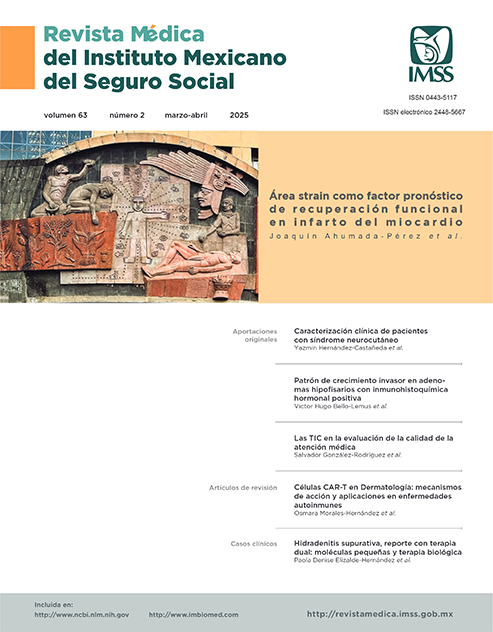Cesarean section risk assessment for pregnant women at term
Main Article Content
Keywords
Risk Factors, Cesarean Section, Labor, Obstetric, Risk Assessment
Abstract
Background: Every year, approximately 140 million births occur, with the majority being spontaneous deliveries in women without risk factors, resulting in vaginal births of healthy newborns.
Objective: To develop a prognostic score to predict the probability of cesarean section in pregnant women at term with a single live fetus presenting with initial labor at hospital admission.
Material and methods: Through a case-control study, pregnant women at term with initial labor at hospital admission were included. Cases were women with labor that culminated in an emergency cesarean section and controls were women who had a normal vaginal delivery. Clinical history was questioned, and a complete physical examination was performed. The odds ratio (OR) and 95% confidence intervals were calculated.
Results: Seventy women were included, 27 cases and 43 controls. There were differences between groups in maternal weight, obesity, primiparity, uterine activity, history of premature rupture of membranes (PROM), cervical dilatation and effacement (p < 0.05). Factors associated with the risk of cesarean delivery were maternal obesity, primiparity, PROM, dilatation < 6 cm, and effacement < 50% (OR ≥ 3.3). Score ≥ 3.5 on the proposed scale is associated with the risk of cesarean delivery with a sensitivity of 81.5% and a specificity of 79%.
Conclusion: Factors associated with the risk of cesarean delivery are maternal obesity, primiparity, and PROM. Score > 3.5 points on the proposed scale is associated with the risk of cesarean delivery.
References
Instituto Mexicano del Seguro Social. Vigilancia y atención amigable en el trabajo de parto en embarazo de bajo riesgo. Guía de Práctica Clínica: Guía de Evidencias y Recomendaciones. México: CENETEC; 2019. Disponible en: https://imss.gob.mx/profesionales-salud/gpc
Rasool MF, Akhtar S, Hussain I, et al. A Cross-Sectional Study to Assess the Frequency and Risk Factors Associated with Cesarean Section in Southern Punjab, Pakistan. Int J Environ Res Public Health. 2021;18(16). doi: 10.3390/ijerph18168812
Antoine C, Young BK. Cesarean section one hundred years 1920-2020: the Good, the Bad and the Ugly. J Perinat Med. 2020;49(1):5-16. doi: 10.1515/jpm-2020-0305
Betran AP, Ye J, Moller AB, et al. Trends and projections of caesarean section rates: global and regional estimates. BMJ Glob Health. 2021;6(6). doi: 10.1136/bmjgh-2021-005671
World Health Organization. WHO statement on caesarean section rates: World Health Organization; 2015. Disponible en: https://iris.who.int/bitstream/handle/10665/161442/WHO_RHR_15.02_eng.pdf?sequence=1
Carlson N, Ellis J, Page K, et al. Review of Evidence-Based Methods for Successful Labor Induction. J Midwifery Womens Health. 2021;66(4):459-69. doi: 10.1111/jmwh.13238
Bishop EH. Pelvic Scoring for Elective Induction. Obstet Gynecol. 1964;24:266-8
Burnett JE, Jr. Preinduction scoring: an objective approach to induction of labor. Obstet Gynecol. 1966;28(4):479-8
Kolkman DGE, Verhoeven CJM, Brinkhorst SJ, et al. The Bishop Score as a Predictor of Labor Induction Success: A Systematic Review. Am J Perinatol. 2013;30(08):625-30. doi: 10.1055/s-0032-1331024
Hernández-Martínez A, Molina-Alarcón M, Pascual-Pedreño AI, et al. Validación de la capacidad predictiva de resultado de parto del índice de Bishop y Burnett modificado por paridad. Anales del Sistema Sanitario de Navarra. 2017;40:351-60
Mikolajczyk RT, Zhang J, Grewal J, et al. Early versus Late Admission to Labor Affects Labor Progression and Risk of Cesarean Section in Nulliparous Women. Front Med (Lausanne). 2016;3:26. doi: 10.3389/fmed.2016.00026
Gjærum R, Johansen IH, Øian P, et al. Associations between cervical dilatation on admission and mode of delivery, a cohort study of Norwegian nulliparous women. Sex Reprod Healthc. 2022;31:100691. doi: 10.1016/j.srhc.2021.100691
Rota A, Antolini L, Colciago E, et al. Timing of hospital admission in labour: latent versus active phase, mode of birth and intrapartum interventions. A correlational study. Women Birth. 2018;31(4):313-8. doi: 10.1016/j.wombi.2017.10.001
Williams MC, Krammer J, O’Brien WF. The value of the cervical score in predicting successful outcome of labor induction. Obstet Gynecol. 1997;90(5):784-9. doi: 10.1016/s0029-7844(97)00415-8
Jafarzadeh A, Hadavi M, Hasanshahi G, et al. Cesarean or Cesarean Epidemic? Arch Iran Med. 2019;22(11):663-70
Boucherie AS, Girault A, Berlingo L, et al. Cesarean delivery on maternal request: How do French obstetricians feel about it? Eur J Obstet Gynecol Reprod Biol. 2022;269:84-9. doi: 10.1016/j.ejogrb.2021.12.006
Singh R, Nath Trivedi A. Is the caesarean section rate a performance indicator of an obstetric unit? J Matern Fetal Neonatal Med. 2011;24(2):204-7. doi: 10.3109/14767058.2010.496501
Herstad L, Klungsøyr K, Skjærven R, et al. Elective cesarean section or not? Maternal age and risk of adverse outcomes at term: a population-based registry study of low-risk primiparous women. BMC Pregnancy Childbirth. 2016;16:230. doi: 10.1186/s12884-016-1028-3
Mylonas I, Friese K. Indications for and Risks of Elective Cesarean Section. Dtsch Arztebl Int. 2015;112(29-30):489-95. doi: 10.3238/arztebl.2015.0489
Takács L, Smolík F, Lacinová L, et al. Emergency cesarean section is a risk factor for depressive symptoms when breastfeeding is limited. J Psychosom Res. 2022;153:110691. doi: 10.1016/j.jpsychores.2021.110691
Lee DS, Tandel MD, Kwan L, et al. Favorable Simplified Bishop Score after cervical ripening associated with decreased cesarean birth rate. Am J Obstet Gynecol MFM. 2022;4(2):100534. doi: 10.1016/j.ajogmf.2021.100534
Jenabi E, Khazaei S, Bashirian S, et al. Reasons for elective cesarean section on maternal request: a systematic review. J Matern Fetal Neonatal Med. 2020;33(22):3867-72. doi: 10.1080/14767058.2019.1587407
Crespo FA, Verma U. High Primary Cesarean Section Rates: Strategies for Improvement. Jt Comm J Qual Patient Saf. 2022; 48(11):617-24. doi: 10.1016/j.jcjq.2022.07.005
Iobst SE, Breman RB, Bingham D, et al. Associations among cervical dilatation at admission, intrapartum care, and birth mode in low-risk, nulliparous women. Birth. 2019;46(2):253-61. doi: 10.1111/birt.12417
Seravalli V, Strambi N, Castellana E, et al. Hospital Admission in the Latent versus the Active Phase of Labor: Comparison of Perinatal Outcomes. Children (Basel). 2022;9(6). doi: 10.3390/ children9060924


